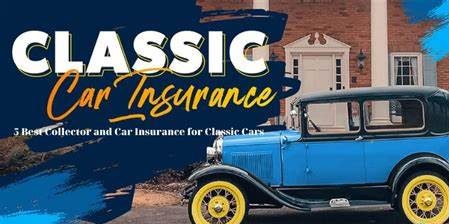A collector automobile is more than simply a car to auto enthusiasts; it’s a labor of love, a piece of history, and a source of pride. However, collector automobiles need specific insurance to make sure they’re adequately covered, unlike regular drivers. Collector automobile insurance provides special benefits designed to meet the demands of these valuable assets.
Why Basic Auto Insurance Is insufficient
Regular drivers are the target market for standard vehicle insurance policy. Their coverage is determined by the vehicle’s current market value, which may be far less than the true worth of a collector automobile. A standard coverage may only cover a portion of the true value of your automobile in the case of a total loss.
Here’s where collector car insurance steps in:
- Agreed Value Coverage: This is the cornerstone of collector car insurance. You and the insurer agree on a predetermined value for your car upfront, considering its condition, rarity, and market value. This guaranteed payout ensures you receive the full worth of your car in a total loss scenario.
- Lower Premiums: Collector cars are driven less frequently and more cautiously compared to daily drivers. Collector car insurance policies reflect this lower risk profile, translating to significantly lower premiums.
- Specialized Coverage: Collector car policies often include features not found in standard policies, such as:
- Parts Coverage: Finding replacement parts for classic cars can be challenging. Collector insurance may offer coverage to help track down new, used, or aftermarket parts.
- Storage Coverage: Collector cars are often stored in garages or specialized facilities. Collector insurance may provide coverage for the vehicle while in storage.
- Car Show and Event Coverage: You might want to take your collector car to shows or events. Collector insurance can provide coverage for these specific situations.
- Mileage Restrictions: Collector car policies typically limit annual mileage driven, further reflecting the reduced risk associated with these vehicles.
How to Get Collector Car Insurance
The process of obtaining collector car insurance is generally straightforward:
- Get an Appraisal: An accurate appraisal is crucial to determine the agreed value of your car. Look for appraisers specializing in collector vehicles who can assess the car’s condition, rarity, and market value.
- Shop Around: Collector car insurance is offered by a variety of companies, including national insurers and specialty providers. Compare quotes and coverage options from different providers to find the best fit for your needs.
- Provide Documentation: Be prepared to furnish the insurer with documentation such as the car’s title, appraisal report, photos, and any maintenance records.
- Discuss Usage: Collector car insurance policies often have mileage restrictions. Discuss your anticipated usage with the insurer to ensure your policy covers your driving habits.
Key Factors to Consider When Choosing a Collector Car Insurance Policy
- Agreed Value vs. Stated Value: Agreed value offers a guaranteed payout, while stated value coverage might base the payout on current market value, potentially resulting in a lower payout.
- Mileage Restrictions: These limitations can vary significantly between insurers. Choose a policy with mileage limits that accommodate your driving habits.
- Replacement Parts Coverage: This can be crucial for older vehicles where parts availability might be limited.
- Car Show and Event Coverage: If you plan to participate in car shows or events, ensure your policy covers these situations.
- Restoration Coverage: If your collector car is undergoing restoration, inquire about coverage options specific to this process.
- Discounts: Many insurers offer discounts for belonging to car clubs, installing security features, or having multiple collector cars insured under the same policy.
Beyond the Basics: Additional Considerations for Collector Car Insurance
- Medical Payments Coverage: This covers medical expenses for you and your passengers in case of an accident, regardless of fault.
- Uninsured/Underinsured Motorist Coverage: This protects you if the driver who caused the accident lacks sufficient insurance to cover your damages.
- Roadside Assistance: A flat tire or a dead battery in your collector car can be a stressful situation. Roadside assistance coverage can provide towing and other roadside services to get you back on the road quickly.
- Agreed Value vs. Stated Value: This is a critical decision. Agreed value offers a guaranteed payout, while stated value coverage might base the payout on current market value, potentially resulting in a lower payout.
Collector car insurance is an investment that safeguards your prized possession. By understanding the unique features and considerations involved, you can choose a policy that provides the peace of mind you deserve, knowing your collector car is protected. Now you can focus on enjoying your classic car and cruising down the road with confidence.
Collector Car Insurance vs. Regular Car Insurance:
| Feature | Collector Car Insurance | Regular Car Insurance |
|---|---|---|
| Coverage Type | Agreed Value or Stated Value | Actual Cash Value (ACV) |
| Payout in Total Loss | Agreed upon value upfront | Current market value (may be lower than actual value) |
| Premium Cost | Lower (due to reduced risk) | Higher (reflects daily driver risk) |
| Mileage Restrictions | Yes (limited annual mileage) | No mileage restrictions |
| Parts Coverage | May cover replacement parts (new, used, or aftermarket) | No parts coverage |
| Storage Coverage | May cover car while in storage | No coverage for storage |
| Car Show/Event Coverage | May offer coverage for car shows and events | No coverage for car shows and events |
| Focus | Classic and collector cars driven infrequently | Everyday vehicles driven regularly |
Additional Considerations




